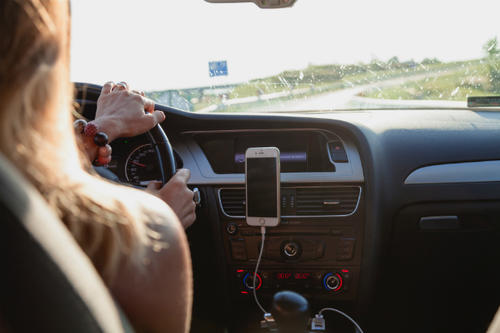Mitigating Distracted Driving

Photo by Peter Fazekas from Pexels
A driver uses a hands-free device in the car.
It seems so simple, taking your eyes off the road to send a quick text to a friend or snapping a photo of yourself in the car, but the consequences of this action are proven to be fatal.
Back in 2017, Missouri documented 2,600 crashes that involved cell phone usage, meaning drivers admittedly drove distracted. Since then, the number has only grown.
According to Missouri law, drivers under the age of 21 are prohibited from engaging in acts of distracted driving, but there are no limitations to drivers over this age. Essentially, Missouri legislatures are sending the message that once a young adults turns 22, they are suddenly skilled enough to balance both looking at a phone and the road ahead while driving.
But this doesn’t necessarily mean that all drivers under 21 are following the law.
In a recent survey, National Youth Risk Behavior found that 39% of high schoolers had texted or emailed while driving during a 30 day period.
Clearly, teens are still going to text and drive whether there is a law in place or not — even if they do not fully admit to it.
So, the question becomes: what can we do to mitigate the risks of distracted driving?
The most effective way for teens to reduce distractions in the car would be to utilize the “Do Not Disturb” feature offered on most devices. With the click of a button, users have the ability to silence all notifications and focus on the road ahead of them. If there were to be an emergency, contacts can reply with “urgent,” and the message will be sent through.
For those who find this feature too extreme, another option is to set up a “hands-free” device in the vehicle. Many of these devices come Bluetooth enabled and have simple operation systems, making it easy to focus on the road and keep both hands on the wheel.
This list of 10 Hands-Free Driving Devices outlines a few of the many options drivers have for hands free assistance.
Technically, drivers don’t even need to use a fancy device or feature at all. Safe drivers could employ the habit of only checking their phones at stop signs or red lights. With this method, drivers are able to focus on the road, but still check their phone every once in a while if needed.
Texting and driving is a serious problem that negatively affects everyone on the road. While we cannot necessarily stop distracted driving from occurring, we can encourage those who text and drive to become safer.

Taylor Kordik is a senior at Mehlville High School. This is her first year in journalism. She is involved in Student Council, Senior Exec, Konnect Mentoring,...







